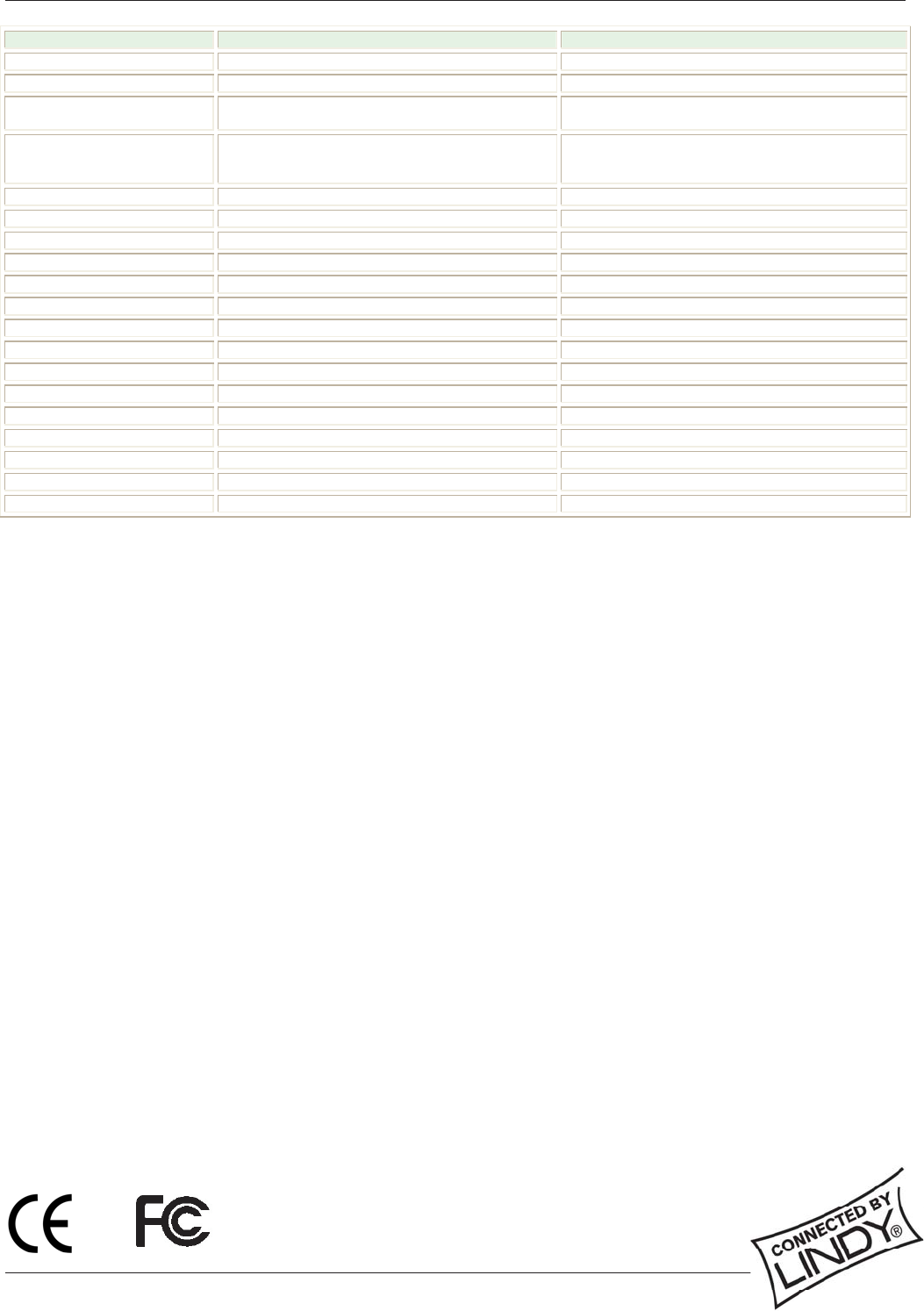
Technical Specifications, Radio Frequency Energy, Certifications
© LINDY ELECTRONICS LIMITED & LINDY-ELEKTRONIK GMBH - FIRST EDITION (MAY 2004)
For Home and Office Use
Tested to Comply with
FCC Standards
Model No. 32825 : 2 Port CPU Switch LITE USB 2.0 32826 : 4 Port CPU Switch LITE USB 2.0
Computer Ports 2 4
Console Port 1 : VGA + (2x PS/2) and/or via USB device ports 1 : VGA + (2x PS/2) and/or via USB device ports
Computer Port Connector
USB Type B receptacle
VGA HD 15pin Female
USB Type B receptacle
VGA HD 15pin Female
Console Port Connector PS/2 Keyboard mini-Din 6 pin Female (or via USB)
PS/2 Mouse mini-Din 6 pin Female (or via USB)
VGA HDDB 15pin Female
PS/2 Keyboard mini-Din 6 pin Female (or via USB)
PS/2 Mouse mini-Din 6 pin Female (or via USB)
VGA HDDB 15pin Female
Computer selection PS/2 PC Hotkey or Button on the CPU Switch PS/2 PC Hotkey or Button on the CPU Switch
LED 2 4
Scan Intervals 5,10,20,30,40,50,60,70,80,90,100 sec. 5,10,20,30,40,50,60,70,80,90,100 sec
Keyboard Conversion PS/2 to USB PS/2 to USB
Mouse Conversion PS/2 to USB PS/2 to USB
VGA Resolution 2048X1536 2048X1536
Bandwidth 400MHz 400MHz
Power Type Bus Power (Optional to Self power mode) Bus Power (Optional to Self power mode)
Power Adapter Switching Power Optional ( DC5V, 2A ) Switching Power Optional (DC5V, 2.5A)
Operation Temperature 0~50 0~50
Storage Temperature -20 ~ 60 -20 ~ 60
Humidity 0~90%, Non-Condensing 0~90%, Non-Condensing
Size Mini Desktop Desktop
Dimension (mm) 118(L)X87(W)X34(H) 186(L)X92(W)X34(H)
Weight (g) 174 293
Shielded cables must be used with this equipment to maintain compliance with radio
frequency energy emission regulations and ensure a suitably high level of immunity to
electromagnetic
disturbances.
FCC Warning
This equipment has been tested and found to comply with the limits for a Class B Digital device,
pursuant to part 15 of the FCC Rules. These limits are designed to provide reasonable protection
against harmful interference in a residential installation. This equipment generates, uses, and can
radiate radio frequency energy and, if not installed and used in accordance with the instructions, may
cause harmful interference to radio communications. However, there is no guarantee that interference
will not occur in a particular installation. If this equipment does cause harmful interference to radio or
television reception, which can be determined by turning the equipment off and on, the user is
encouraged to try to correct the interference by one or more of the following measures:
Reorient or relocate the receiving antenna
Increase the separation between the equipment and receiver
Connect the equipment into an outlet on a circuit different from that to which the receiver is
connected
Consult the dealer or an experienced technician for help
You are cautioned that changes or modifications not expressly approved by the party responsible for
compliance could void your authority to operate the equipment.
This device complies with part 15 of the FCC Rules.
Operation is subject to the following two conditions:
1. This device may not cause harmful interference, and
2. This device must accept any interference received, including interference that may cause undesired
operation


















